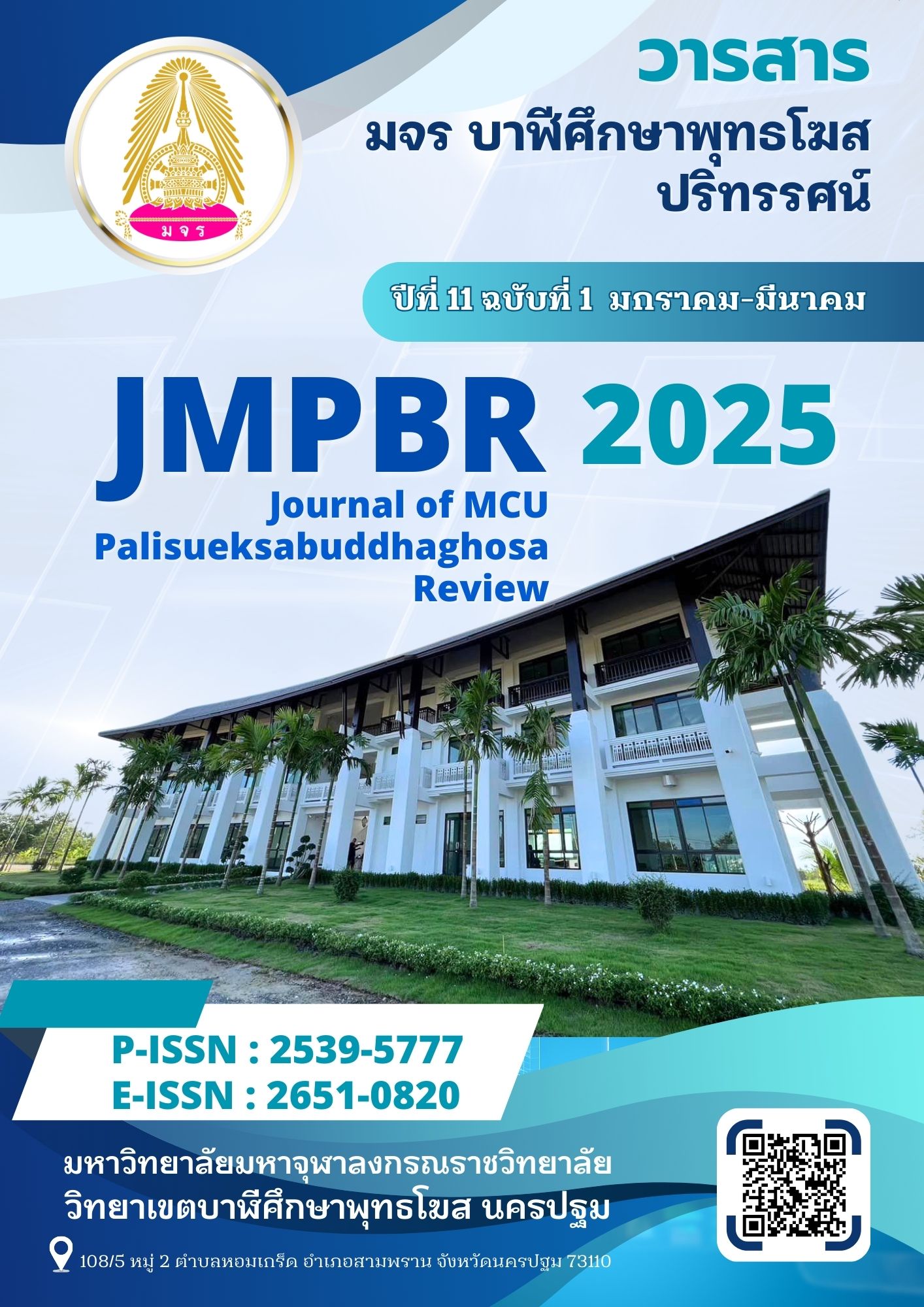An Analysis of the Enlightenment of Phra Gisa Kotami Theri
Main Article Content
Abstract
This research paper aims has two objectives; 1) to study the enlightenment in Theravada Buddhist scriptures and history of the practice of the perfections of Gisa Gotami Their, 2) to analyze the enlightenment of Kisagotami Theri, by taking the data from Theravada Buddhist scriptures, i.e. Tipitaka and other related scriptures and related documents, collected, summarized, analyzed, then composed and presented them in a narrative and descriptive format, verified by experts.
From the study, it was found that the enlightenment in Buddhism means realization of the Four Noble Truths; suffering, cause of suffering, extinction of suffering, and path leading to extinction of suffering. This realization will bring up the attainment of Nine Supramundane; Four Paths, Four Fruitions, and Nibbana, which abandoned all fetters or Sanyojana in respect of insight knowledge. It was divided into 4 levels; 1) Sotapanna can eliminate Sakkāyadiṭṭhi, Vicikicchā, and Sīlabbataparamāsa, 2) Sakadāgāmī can reduce lust and aversion, 3) Anāgāmi can eliminate all three fetters, including sensual desire and aversion, 4) Arahant can eliminate all remaining fetters; Rūpa-rāga, Arupa-rāga, Māna, Ucdattacā, and Avijjā completely. Kisāgotami Theri began to accumulate merit and made her aspiration to be the foremost female disciple of the one wearing a tarnished robe; in time Buddha name Padumutara to present Buddha and perfection cultivation continued. She had experienced suffering losing beloved son to lost conciousness; listened to the Buddha's teaching, attained initial supramundane and asked to be ordained as nun; after that she practiced vipassana using flame of a lamp as its contemplation seeing the fluctuation and impermanence, so raised mind to vipassana, wisdom arose, and fully realized the four noble truths according to the principle of the four foundations of mindfulness, which is the determined to be aware of arising and passing away that appear in the body, feelings, mind and dhamma; it is the determined to know five aggregates to know them as three characteristics according to reality. Finally, Kisāgotami Theri was able to attain the Noble Path, Fruitions, Nibbana; achieved of an arahant.
Article Details

This work is licensed under a Creative Commons Attribution-NonCommercial-NoDerivatives 4.0 International License.
Copyright Notice
The content and information in the articles published in Journal of MCU Palisueksabuddhaghosa Review, are regarded as opinions and responsibilities of article author only. It definitely does not mean that the editor must agree or share any responsibility to the author.
Articles, information, content, figure etc. that have been published in the Journal of MCU Palisueksabuddhaghosa Review is considered as the copyright of the Journal. If any individual or organization will to bring any parts of article for promote or to do anything, must be licensed only in official form from the Journal of MCU Palisueksabuddhaghosa Review.
The content and information in the articles published in Journal of MCU Palisueksabuddhaghosa Review, are regarded as opinions and responsibilities of article author only. It definitely does not mean that the editor must agree or share any responsibility to the author.
Articles, information, content, figure etc. that have been published in the Journal of MCU Palisueksabuddhaghosa Review is considered as the copyright of the Journal. If any individual or organization will to bring any parts of article for promote or to do anything, must be licensed only in official form from the Journal of MCU Palisueksabuddhaghosa Review.
References
พระไตรปิฎกภาษาไทย ฉบับมหาจุฬาลงกรณราชวิทยาลัย. กรุงเทพมหานคร: โรงพิมพ์มหาจุฬาลงกรณราชวิทยาลัย, 2539.
พระพรหมคุณาภรณ์ (ป.อ.ปยุตโต), พุทธธรรม ฉบับปรับขยายความ, พิมพ์ครั้งที่ 41, กรุงเทพมหานคร: สำนักพิมพ์ผลิธัมม์, 2558.
พระประสาน ชยภิรโต (อร่ามวาณิชย์), “กระบวนการบรรลุธรรมของพุทธสาวิกาในพุทธปรัชญาเถรวาท”,วิทยานิพนธ์ ศาสนศาสตรมหาบัณฑิต, บัณฑิตวิทยาลัย: มหาวิทยาลัยมหามกุฏราชวิทยาลัย, 2563.
พระสมชาย กิตฺติสาโร (แก้วเกษม), “ศึกษาการบรรลุธรรมของพระมหากัจจายนเถระ”, สาระนิพนธ์พุทธศาสตรมหาบัณฑิต, บัณฑิตวิทยาลัย: มหาวิทยาลัยมหาจุฬาลงกรณราชวิทยาลัย, 2561.
พระโสภณมหาเถระ (มหาสีสยาดอ), รจนา, ปฏิจจสมุปบาท เหตุผลแห่งวัฏสงสาร, พระพรหมโมลี(สมศักดิ์ อุปสมมหาเถระ ป.ธ.9, M.A.,Ph.D.) ตรวจชำระ.พระคันธสาราภิวงศ์. แปลและเรียบเรียง กรุงเทพมหานคร: โรงพิมพ์ หจก.ประยูรสาส์นไทยการพิมพ์, 2553.

